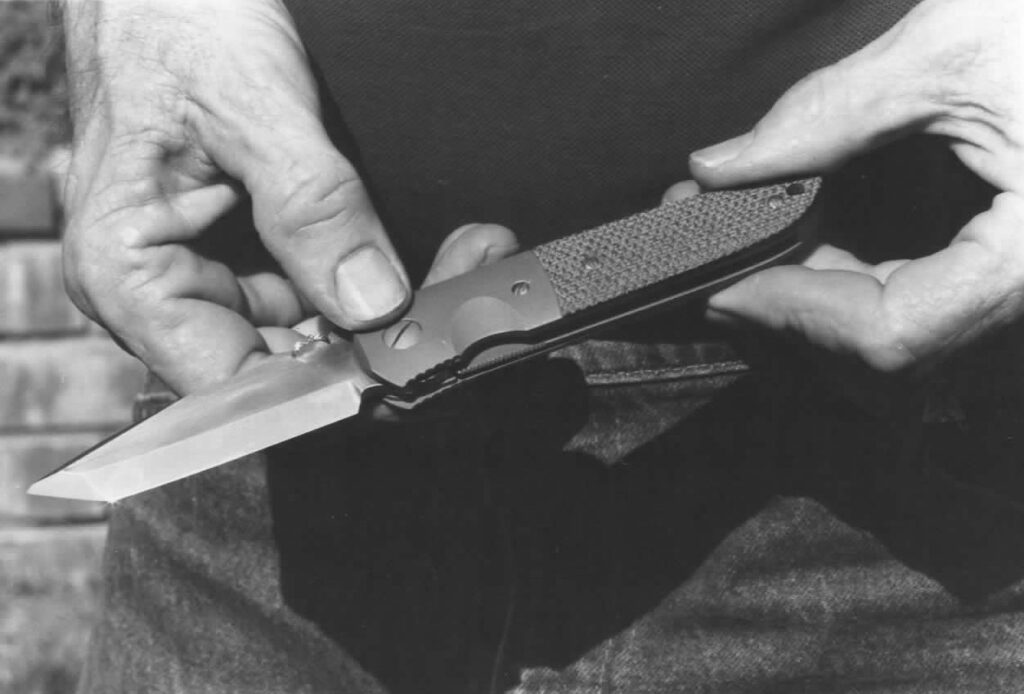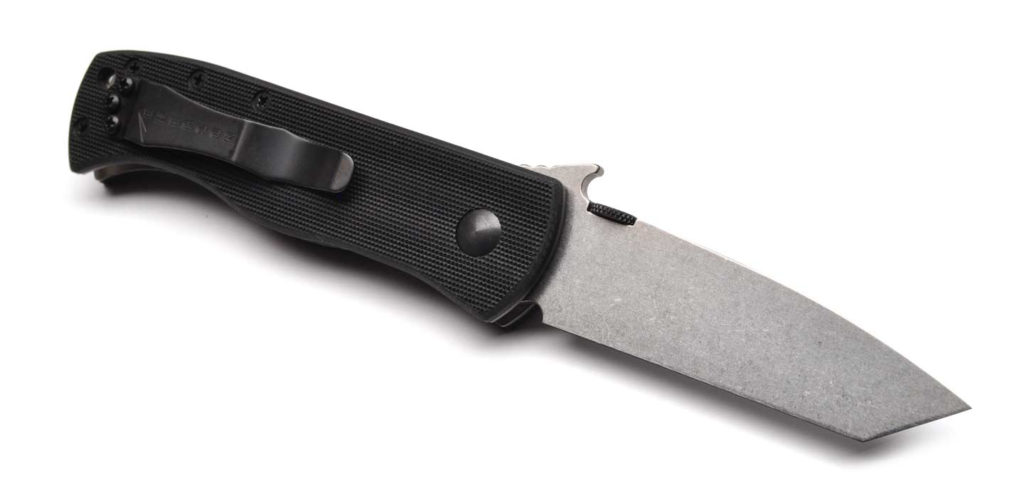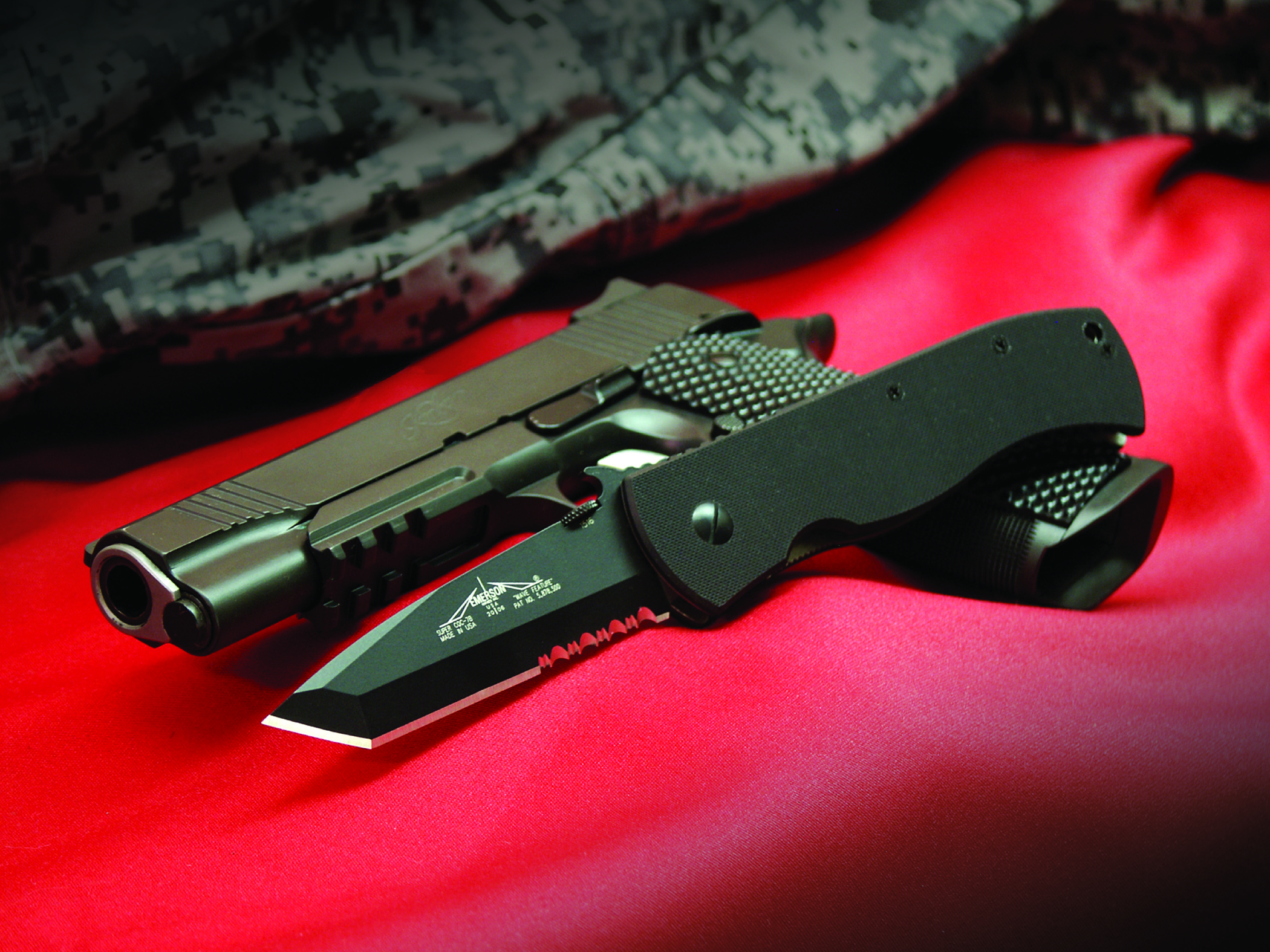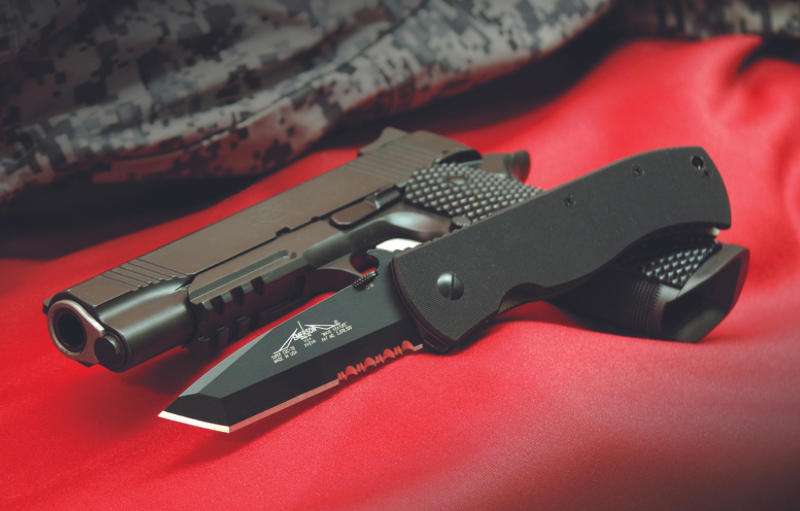Why it is the way it is.
Well, let's start with this. First off, the CQC-7 is a knife, nothing more. Simply, it had to do everything a knife must do. It has to cut, slice, chop, and stab. It had to be a size that will fit in your kit, gear, or pocket, so you will have it with you all of the time, just like a concealed carry firearm. If it's too big or bulky to have on you, it's not going to do you any good if it's sitting in a safe. It had to be able to deploy quickly and easily in a time of immediate need with one-hand operation. The grip had to be comfortable and secure in the hand – in any grip position – during hard use situations. And the knife must be constructed of tough, durable, and dependable materials to withstand exposure to the elements and use in any number of environments. And it must be impervious to oil, water, gasoline, and various other chemicals and solvents and liquids.

And here is the real secret as to what is an absolute requirement in order for a knife to be a true tactical knife. Most tactical knife makers don’t even know this because everyone started doing it because we did it and it soon became the norm for all tactical knife designs. It’s the reason why our knife was constructed the way it was. To be a true tactical knife, you need to be able to take it apart, completely disassemble it, clean it, and then put it back together again. This also enables you to clean, change and modify parts of the knife just like a tactical rifle or a combat ray pistol. In fact, the CQC-7 was designed with the concept of firearm in mind. Now, it may be argued that Ernest Emerson did not build the first take-apart knife. (maybe at least one of the first, remember I started in 1979, and that's 45 years ago). But suffice it to say, Emerson Knives Inc. was the very first commercial knife company to make take-apart knives, and the first to not only offer, but encourage the disassembly of our knives by the owners. That “other knife company” that I mentioned in the beginning of the story, would actually void your warranty if you took one of their knives apart. Before us, everybody's knives were riveted or glued together. In fact, on a side note the Emerson “take apart “feature spawned an entire cottage industry, “knife pimping,” the ability to build custom parts and “dress up” your Emerson knife soon spread all across the world, and later to other companies as well.
“Once again, that “other knife company” did not want to embrace that concept because it was, “too offensive,” and aggressive for them.”
And by the way, did you know that Emerson knives was the first all-tactical knife company? Once again, that “other knife company” did not want to embrace that concept because it was, “too offensive,” and aggressive for them. Well, be that as it may, but in the long run, thank goodness for that because it gave us a reason to exist and thrive.
I happen to be default aggressive by nature. And it's also one of the numerous reasons I broke away from that company to start my own. I once told the owner and his wife, “You're scared of being too offensive and you're scared it would harm your reputation. How offensive or aggressive do you think a gun company is? It doesn't seem to hurt Glock, Sig, H&K or Colt too much.”
But they wouldn't have it, and so I decided to move on. I actually think they forgot who called them in the first place to collaborate with me. Navy SEALs, after all, are pretty default aggressive by nature themselves, but I digress.
There had never been a blade on a folding knife like the CQC-7 before anywhere in the knife industry.
Now, as many of you know, I'm a fighter, an instructor, and some might say an edged weapons expert. I had, after all, been training some of the baddest and the best how to survive mortal combat since the mid-1980s, and I had done this literally all over the world.
As a result, you might surmise that I had, let's say, an obsession with weapons. Not just knives, but yes, mainly knives and of course swords and everything else in between. And I also collect things, from ancient 80,000-year-old, flaked neanderthal tools, to 25,000-year-old neolithic hand axes, ancient Roman swords and weapons, ancient Persian edged weapons, Viking axes and swords, medieval swords, axes, and weapons, all authentic, and dating back thousands of years through the millennia. And of course, I also collect Japanese Samurai swords. I have a respectable collection of 200 to 500-year-old katanas, wakizashis, and Tantos, all authentic Samurai-era weapons. In fact, in the early 2000s, I had the opportunity to travel to Japan and got to work in the forge of a sixth generation Swordsmith, a Japanese “living treasure” at his forge in Saki City, Japan. So how does all of this relate to the CQC-7? Well just take a look at it, I'm sure you can see the influence there.
 When I was developing the CQC-7's precursor, the CQC-6 knife, I was asked to design a knife that would penetrate soft body armor (Kevlar). I knew that the Japanese Samurai relied on hard leather and sewn on iron plates, (a lot like the Lorica segmentata of the ancient Roman Legionnaires) And the Japanese Samurai swords and personal weapons had points that were developed to overcome this armor. So, as you can see, that's also a part of the reason for the Japanese influence in the blade of the CQC-7.
When I was developing the CQC-7's precursor, the CQC-6 knife, I was asked to design a knife that would penetrate soft body armor (Kevlar). I knew that the Japanese Samurai relied on hard leather and sewn on iron plates, (a lot like the Lorica segmentata of the ancient Roman Legionnaires) And the Japanese Samurai swords and personal weapons had points that were developed to overcome this armor. So, as you can see, that's also a part of the reason for the Japanese influence in the blade of the CQC-7.
But wait, there's more – much more. I did not design the Emerson Tanto CQC-7 knife just because I was enamored with Japanese blades. But I must admit, of course, it was a factor.
Now I know I wasn't the first to make a Tanto-style blade. There was of course Lynn Thompson (Cold Steel) and well-known custom maker, Mr. Bob Lum. But the first to make this specific style of Americanized Tanto on a commercial folding knife, well, that was us.
Why the chisel grind on the blade?
Why the chisel grind on the blade? Well, there was a very well-respected custom knife maker named Phil Hartsfield. And he made what I believed to be the sharpest, toughest, and strongest knives I've ever seen. They were “chisel ground”, meaning the bevel was ground only on one side and continued right down to the very edge – just like a chisel. Well, by some coincidence, some of his customers were the same customers as mine, (SPECWAR) but Phil made fixed blade, Japanese-style blades, and swords. Of course, along with other styles of fixed blades however, he did not make folding knives. The group I was working with wanted a folder with a blade carrying that same sharpness and strength. That's how I entered the story. I called Phil, introduced myself and asked if I could have his permission to use his signature chisel grind on the folder, I was tasked with developing. He agreed, and later he told me, “Ernest, you're the first guy that ever asked me for permission. The other makers just copy my stuff and never even give me credit. I want to thank you for that. It was the right thing to do.” Phil and I became friends. But wait, once again, there's still more. I was asked if I could develop a blade that could be used for scraping a spot, let's say, on the hull of a ship, so something could be attached. And that was one of the requirements that they specified about the knife that I was developing. Now, as you can surmise, that scraping action would dull any blade very quickly, but they still wanted to have a sharp edge undamaged on the same knife, even after scraping barnacles, let's say off the steel braces on an oil rig. So how was I going to do that? I thought you would need to have two edges on the same blade. So how was I going to do that? And the design answer was by having edges that are kept separate from each other by designing those edges, so they are at two dramatic and separate angles from each other.
But wait, once again, there's still more. I was asked if I could develop a blade that could be used for scraping a spot, let's say, on the hull of a ship, so something could be attached. And that was one of the requirements that they specified about the knife that I was developing. Now, as you can surmise, that scraping action would dull any blade very quickly, but they still wanted to have a sharp edge undamaged on the same knife, even after scraping barnacles, let's say off the steel braces on an oil rig. So how was I going to do that? I thought you would need to have two edges on the same blade. So how was I going to do that? And the design answer was by having edges that are kept separate from each other by designing those edges, so they are at two dramatic and separate angles from each other.
So, in use, one edge can be used without engaging the second edge, and the Emerson American Tanto style was born. Instead of having the graceful or transitional change from cutting edge to the point as is common on Japanese armor piercing points. I made it with a very abrupt up angle and separated the two edges in a way that allowed them to be used independently.
That brings us to the end of part one, the CQC-7 design concepts. The next installment we'll take up with some of the more salient points about the mechanical development of the CQC-7 knife.





What an incredible story. I have to say, when you asked permission to use Phils design that’s RESPECT.
That why I buy and carry Emerson knives, cause I know how much HEART, BLOOD, SWEAT, TEARS and RESPECT is put into each blade born out of your headquarters. CHEERS
OBS member #2123 forever